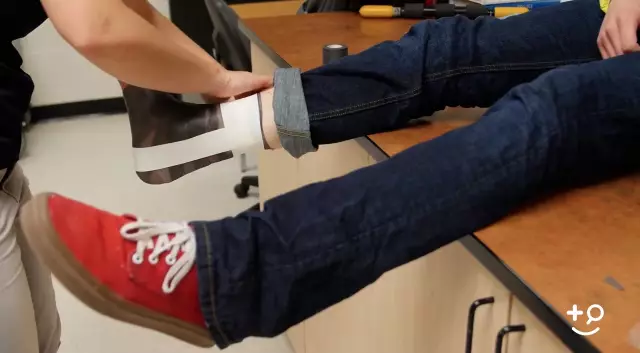- Author Curtis Blomfield [email protected].
- Public 2023-12-16 20:44.
- Last modified 2025-01-23 17:01.
Ankle sprain is a fairly common injury, especially among people involved in sports. This condition is accompanied by damage, and sometimes rupture of the tendons. How dangerous can an injury be and what methods of treatment are used by modern medicine?
Main causes of damage

As mentioned, ankle sprains are a common problem among athletes. It is not uncommon for a tendon injury to result from a sharp inward or outward twisting of the foot. This happens, for example, when walking on uneven or slippery surfaces (most often in the winter season), as well as when wearing uncomfortable high-heeled shoes. Sometimes the cause is a sharp blow that causes the foot to arch unnaturally.
On the other hand, there are some risk groups. It has been proven that people with high arches are more prone to this type of injury. In addition, negative factors include congenital or acquiredligament weakness and certain diseases that affect muscle fibers.
What are the main symptoms of a sprain?
The main signs of injury depend primarily on the degree of damage. A slight sprain of the ankle ligament, which is accompanied only by microdamages in the tissues, responds with pain and discomfort while walking. If there is a partial rupture of the ligaments, then the symptoms are already more noticeable - the patient complains of stiffness and severe pain that occurs even with the slightest movement. Often, the tissues in the joint area are very swollen.

Tendon rupture has the most striking clinical picture, it can be seen on x-rays. The pain becomes so intense that the person cannot walk. Severe persistent swelling develops in the area of injury, and the skin becomes red and hot to the touch.
How serious is the injury?
Rupture or sprain of the ankle ligament in the absence of qualified assistance can lead to a host of complications. After all, an ankle joint with damaged tendons becomes extremely unstable, which is accompanied by an increased tendency to such injuries even with the slightest physical activity. Complications include stiffness of movement. In addition, an unstable joint often leads to gradual destruction of muscle and bone tissue.
Ankle sprain: how to treat?
With an injury like this, it is best to see a doctor, as only a specialist can determine the severity of the damage. Light stretchcan be treated at home - you need to put a tight fixing bandage on your leg, which will restrict movement and prevent the formation of edema. Bed rest with minimal physical activity is recommended for the first 2-4 days.

Partial ligament ruptures are accompanied by more pronounced symptoms. Therefore, here, in addition to a tight tourniquet and complete rest, anesthesia is also required. An ointment for ankle sprains is effective, which contains not only analgesics, but also anti-inflammatory components. Examples include Indomethacin, Diclofenac, Ibuprofen.
Complete tissue rupture requires longer therapy. For anesthesia, intramuscular injections of novocaine are carried out. In such cases, a regular bandage is not enough, so the doctor applies a cast to completely immobilize the joint. After two weeks, you can start special training, which must necessarily take place under the supervision of a specialist. Therapeutic gymnastics is an important component of therapy, as it allows you to slowly restore the mobility of muscles and tendons.






